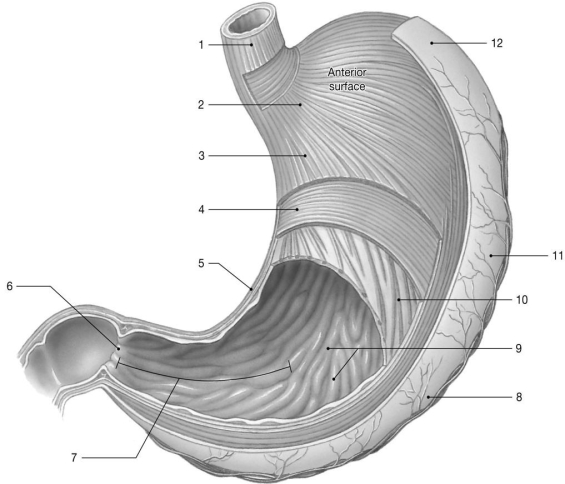A) stomach.
B) duodenum.
C) jejunum.
D) ileum.
E) colon.
Correct Answer

verified
Correct Answer
verified
Multiple Choice
Waves of muscular contractions that propel the contents of the digestive tract are called
A) segmentations.
B) pendular movements.
C) peristalsis.
D) churning movements.
E) mastication.
Correct Answer

verified
Correct Answer
verified
Multiple Choice
The portion of the stomach that is superior to the junction between the stomach and the esophagus is the
A) cardia.
B) pylorus.
C) fundus.
D) antrum.
E) body.
Correct Answer

verified
Correct Answer
verified
Multiple Choice
An enzyme secreted by the gastric mucosa of a newborn that assists in the digestion of milk proteins is
A) pepsin.
B) trypsin.
C) gastrin.
D) rennin.
E) cholecystokinin.
Correct Answer

verified
Correct Answer
verified
Multiple Choice
The part of the digestive tract that plays the primary role in chemical digestion and nutrient absorption is the
A) cecum.
B) jejunum.
C) stomach.
D) duodenum.
E) colon.
Correct Answer

verified
Correct Answer
verified
Multiple Choice
A viral infection that often involves the parotid glands,which swell noticeably,is
A) gastric ulceration.
B) hepatitis.
C) cirrhosis.
D) mumps.
E) HIV.
Correct Answer

verified
Correct Answer
verified
Multiple Choice
What is the primary digestive function of the pancreas?
A) to produce hormones that increase digestion in the small intestine
B) to produce acid for the digestion of proteins in the stomach
C) to produce mucus for the ease of feces passing through the rectum
D) to produce bile for the digestion of lipids
E) to produce buffers and enzymes for the digestion of starches,lipids,nucleic acids,and proteins
Correct Answer

verified
Correct Answer
verified
Multiple Choice
________ are also known as canines.
A) Bicuspids
B) Incisors
C) Molars
D) Secondary teeth
E) Cuspids
Correct Answer

verified
Correct Answer
verified
Multiple Choice
All of the following enzymes are secreted by the pancreas except
A) trypsin.
B) amylase.
C) nuclease.
D) chymotrypsin.
E) insulin.
Correct Answer

verified
Correct Answer
verified
Multiple Choice
List the accessory organs of the digestive system.
A) oral cavity,teeth,tongue,salivary glands,esophagus
B) oral cavity,salivary glands,esophagus,stomach,liver
C) teeth,tongue,salivary glands,liver,gallbladder,pancreas
D) teeth,tongue,stomach,liver,gallbladder,large intestine
E) pharynx,esophagus,stomach,liver,gallbladder,pancreas
Correct Answer

verified
Correct Answer
verified
Multiple Choice
Define ingestion.
A) The movement of nutrients across the digestive epithelium and into the bloodstream.
B) The discharge of feces.
C) The enzymatic breakdown of food.
D) Entry of food and liquids into the digestive tract through the mouth.
E) The crushing and shearing of food.
Correct Answer

verified
Correct Answer
verified
Multiple Choice
 Figure 22-2
-Which structure controls the contraction of the muscular layer?
Figure 22-2
-Which structure controls the contraction of the muscular layer?
A) muscularis mucosae (2)
B) submucosal plexus (8)
C) circular layer of smooth muscle (9)
D) myenteric plexus (10)
E) longitudinal layer of smooth muscle (11)
Correct Answer

verified
Correct Answer
verified
Multiple Choice
 Figure 21-1
-Which structure helps the stomach to stretch as it fills with food?
Figure 21-1
-Which structure helps the stomach to stretch as it fills with food?
A) 3
B) 4
C) 5
D) 6
E) 9
Correct Answer

verified
Correct Answer
verified
Multiple Choice
Distinguish between chemical digestion and absorption.
A) Chemical digestion involves the entry of food and liquid into the digestive tract,whereas absorption involves the discharge of indigestible food into material waste.
B) Chemical digestion involves the breakdown of food,whereas absorption involves the movement of nutrients across the digestive epithelium into the interstitial fluid.
C) Chemical digestion involves the discharge of indigestible food into material waste,whereas absorption involves the entry to food and liquid into the digestive tract.
D) Chemical digestion involves the crushing and shearing of food,whereas absorption involves the movement of nutrients across the digestive epithelium into the interstitial fluid.
E) Chemical digestion involves the movement of food along the digestive tract,whereas absorption involves the secretion of acids,enzymes,and buffers.
Correct Answer

verified
Correct Answer
verified
Multiple Choice
Which of these descriptions best matches the term "submucosal plexus"?
A) component of mucosa
B) includes a sensory neural network
C) secretes a watery fluid
D) coordinates activity of the muscular layer
E) loose connective tissue layer containing blood vessels
Correct Answer

verified
Correct Answer
verified
Multiple Choice
Mary had most of her stomach surgically removed in an effort to overcome obesity.As a result,Mary can expect to be at risk for
A) protein malnutrition.
B) vitamin B12 deficiency.
C) diarrhea.
D) dehydration.
E) an ulcer.
Correct Answer

verified
Correct Answer
verified
Multiple Choice
Name the major functions of the large intestine.
A) producing digestive enzymes,producing acidic chyme,digesting proteins,fats and carbohydrates
B) reabsorbing water and compacting material into feces,absorbing vitamins,and storing fecal material
C) detoxifying alcohol and drugs,producing bile,storing bile
D) producing buffers,absorbing vitamins,and storing bile
E) emulsifying lipids,synthesizing clotting factors,and absorbing and inactivating lipid-soluble drugs
Correct Answer

verified
Correct Answer
verified
Multiple Choice
At what point in the large intestine does the epidermis change from stratified squamous non-keratinized tissue like the oral cavity to stratified squamous keratinized tissue like the skin?
A) descending colon
B) internal anal sphincter
C) anus
D) rectum
E) sigmoid colon
Correct Answer

verified
Correct Answer
verified
Multiple Choice
Which of the following is classified as being either squamous or columnar?
A) submucosa
B) mucosal epithelium
C) muscularis mucosae
D) lamina propria
E) mucosa
Correct Answer

verified
Correct Answer
verified
Multiple Choice
The intestinal hormone that stimulates the pancreas to release enzymes and buffers is
A) vasoactive intestinal peptide (VIP) .
B) secretin.
C) lipase.
D) gastric inhibitory peptide (GIP) .
E) gastrin.
Correct Answer

verified
Correct Answer
verified
Showing 141 - 160 of 255
Related Exams